Final Assignment: MCO201 Finance Case Study on Medical Inc. Project
VerifiedAdded on 2022/08/26
|6
|950
|13
Case Study
AI Summary
This document presents a comprehensive analysis of two finance case studies. Case 1 focuses on Medical Inc., evaluating a new dental implant project using capital budgeting techniques. It calculates cash flows, payback period, profitability index, NPV, and IRR to determine the project's financial viability, recommending acceptance based on positive NPV and other favorable metrics. Case 2 analyzes Tesla's financial structure, calculating the debt-to-equity ratio, market value of equity, and cost of capital. It determines the cost of equity using CAPM, yield to maturity, and WACC using both book and market value weights. The document also addresses the pure play method, discussing potential issues in determining the cost of capital for companies with limited publicly available information. The analysis provides detailed calculations and recommendations based on financial principles.

BUSINESS FINANCE
Paraphrase This Document
Need a fresh take? Get an instant paraphrase of this document with our AI Paraphraser
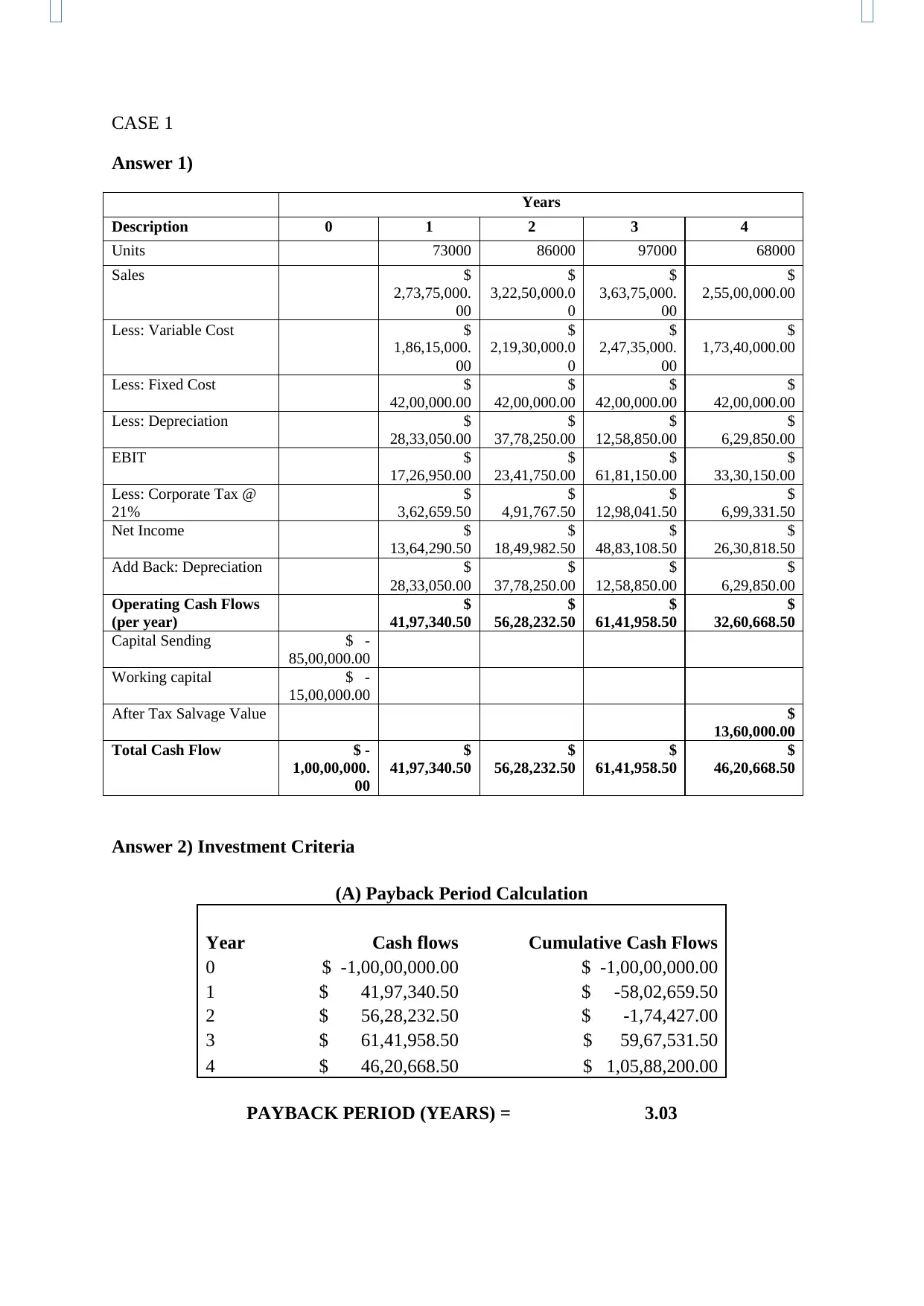
CASE 1
Answer 1)
Years
Description 0 1 2 3 4
Units 73000 86000 97000 68000
Sales $
2,73,75,000.
00
$
3,22,50,000.0
0
$
3,63,75,000.
00
$
2,55,00,000.00
Less: Variable Cost $
1,86,15,000.
00
$
2,19,30,000.0
0
$
2,47,35,000.
00
$
1,73,40,000.00
Less: Fixed Cost $
42,00,000.00
$
42,00,000.00
$
42,00,000.00
$
42,00,000.00
Less: Depreciation $
28,33,050.00
$
37,78,250.00
$
12,58,850.00
$
6,29,850.00
EBIT $
17,26,950.00
$
23,41,750.00
$
61,81,150.00
$
33,30,150.00
Less: Corporate Tax @
21%
$
3,62,659.50
$
4,91,767.50
$
12,98,041.50
$
6,99,331.50
Net Income $
13,64,290.50
$
18,49,982.50
$
48,83,108.50
$
26,30,818.50
Add Back: Depreciation $
28,33,050.00
$
37,78,250.00
$
12,58,850.00
$
6,29,850.00
Operating Cash Flows
(per year)
$
41,97,340.50
$
56,28,232.50
$
61,41,958.50
$
32,60,668.50
Capital Sending $ -
85,00,000.00
Working capital $ -
15,00,000.00
After Tax Salvage Value $
13,60,000.00
Total Cash Flow $ -
1,00,00,000.
00
$
41,97,340.50
$
56,28,232.50
$
61,41,958.50
$
46,20,668.50
Answer 2) Investment Criteria
(A) Payback Period Calculation
Year Cash flows Cumulative Cash Flows
0 $ -1,00,00,000.00 $ -1,00,00,000.00
1 $ 41,97,340.50 $ -58,02,659.50
2 $ 56,28,232.50 $ -1,74,427.00
3 $ 61,41,958.50 $ 59,67,531.50
4 $ 46,20,668.50 $ 1,05,88,200.00
PAYBACK PERIOD (YEARS) = 3.03
Answer 1)
Years
Description 0 1 2 3 4
Units 73000 86000 97000 68000
Sales $
2,73,75,000.
00
$
3,22,50,000.0
0
$
3,63,75,000.
00
$
2,55,00,000.00
Less: Variable Cost $
1,86,15,000.
00
$
2,19,30,000.0
0
$
2,47,35,000.
00
$
1,73,40,000.00
Less: Fixed Cost $
42,00,000.00
$
42,00,000.00
$
42,00,000.00
$
42,00,000.00
Less: Depreciation $
28,33,050.00
$
37,78,250.00
$
12,58,850.00
$
6,29,850.00
EBIT $
17,26,950.00
$
23,41,750.00
$
61,81,150.00
$
33,30,150.00
Less: Corporate Tax @
21%
$
3,62,659.50
$
4,91,767.50
$
12,98,041.50
$
6,99,331.50
Net Income $
13,64,290.50
$
18,49,982.50
$
48,83,108.50
$
26,30,818.50
Add Back: Depreciation $
28,33,050.00
$
37,78,250.00
$
12,58,850.00
$
6,29,850.00
Operating Cash Flows
(per year)
$
41,97,340.50
$
56,28,232.50
$
61,41,958.50
$
32,60,668.50
Capital Sending $ -
85,00,000.00
Working capital $ -
15,00,000.00
After Tax Salvage Value $
13,60,000.00
Total Cash Flow $ -
1,00,00,000.
00
$
41,97,340.50
$
56,28,232.50
$
61,41,958.50
$
46,20,668.50
Answer 2) Investment Criteria
(A) Payback Period Calculation
Year Cash flows Cumulative Cash Flows
0 $ -1,00,00,000.00 $ -1,00,00,000.00
1 $ 41,97,340.50 $ -58,02,659.50
2 $ 56,28,232.50 $ -1,74,427.00
3 $ 61,41,958.50 $ 59,67,531.50
4 $ 46,20,668.50 $ 1,05,88,200.00
PAYBACK PERIOD (YEARS) = 3.03
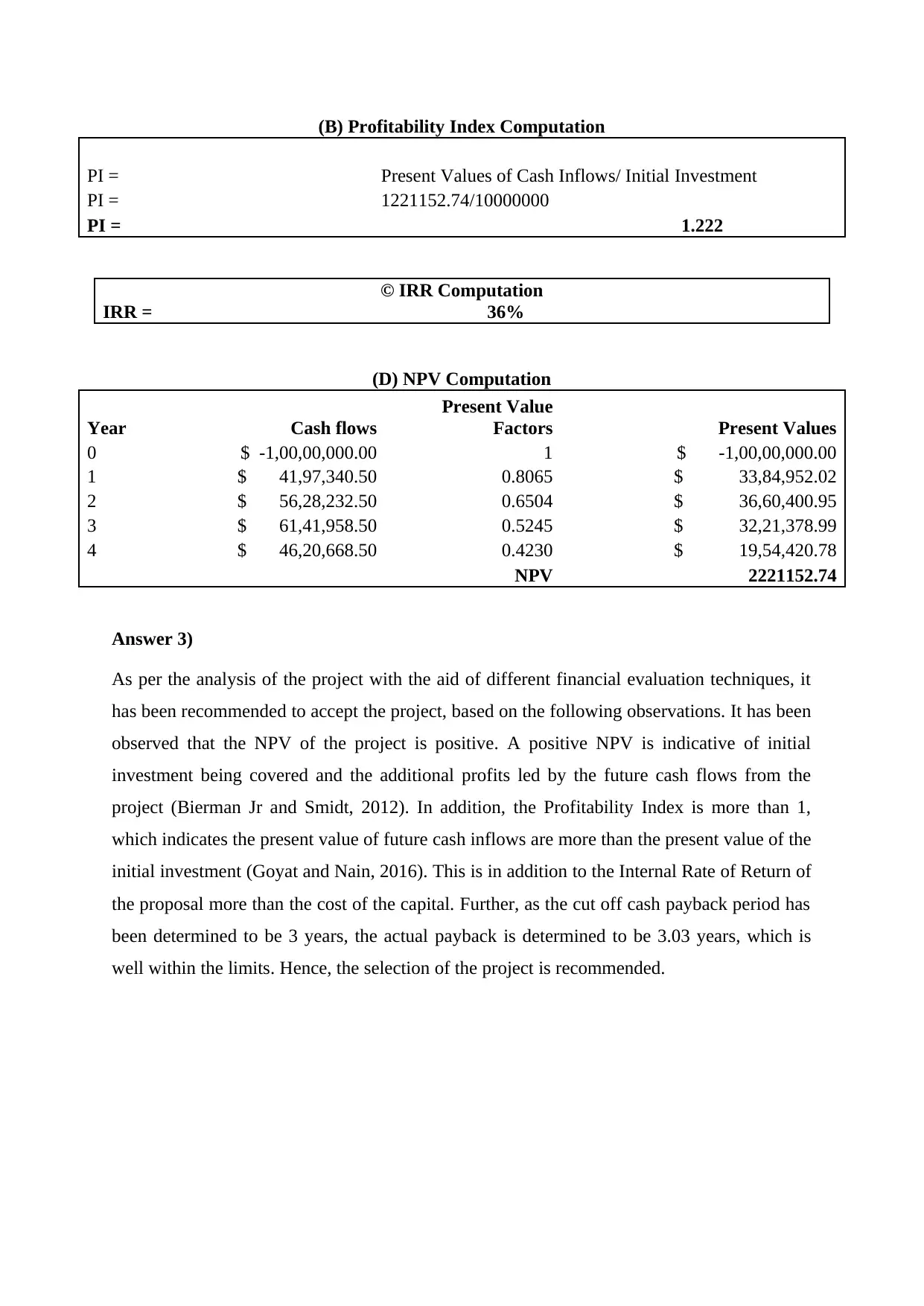
(B) Profitability Index Computation
PI = Present Values of Cash Inflows/ Initial Investment
PI = 1221152.74/10000000
PI = 1.222
© IRR Computation
IRR = 36%
(D) NPV Computation
Year Cash flows
Present Value
Factors Present Values
0 $ -1,00,00,000.00 1 $ -1,00,00,000.00
1 $ 41,97,340.50 0.8065 $ 33,84,952.02
2 $ 56,28,232.50 0.6504 $ 36,60,400.95
3 $ 61,41,958.50 0.5245 $ 32,21,378.99
4 $ 46,20,668.50 0.4230 $ 19,54,420.78
NPV 2221152.74
Answer 3)
As per the analysis of the project with the aid of different financial evaluation techniques, it
has been recommended to accept the project, based on the following observations. It has been
observed that the NPV of the project is positive. A positive NPV is indicative of initial
investment being covered and the additional profits led by the future cash flows from the
project (Bierman Jr and Smidt, 2012). In addition, the Profitability Index is more than 1,
which indicates the present value of future cash inflows are more than the present value of the
initial investment (Goyat and Nain, 2016). This is in addition to the Internal Rate of Return of
the proposal more than the cost of the capital. Further, as the cut off cash payback period has
been determined to be 3 years, the actual payback is determined to be 3.03 years, which is
well within the limits. Hence, the selection of the project is recommended.
PI = Present Values of Cash Inflows/ Initial Investment
PI = 1221152.74/10000000
PI = 1.222
© IRR Computation
IRR = 36%
(D) NPV Computation
Year Cash flows
Present Value
Factors Present Values
0 $ -1,00,00,000.00 1 $ -1,00,00,000.00
1 $ 41,97,340.50 0.8065 $ 33,84,952.02
2 $ 56,28,232.50 0.6504 $ 36,60,400.95
3 $ 61,41,958.50 0.5245 $ 32,21,378.99
4 $ 46,20,668.50 0.4230 $ 19,54,420.78
NPV 2221152.74
Answer 3)
As per the analysis of the project with the aid of different financial evaluation techniques, it
has been recommended to accept the project, based on the following observations. It has been
observed that the NPV of the project is positive. A positive NPV is indicative of initial
investment being covered and the additional profits led by the future cash flows from the
project (Bierman Jr and Smidt, 2012). In addition, the Profitability Index is more than 1,
which indicates the present value of future cash inflows are more than the present value of the
initial investment (Goyat and Nain, 2016). This is in addition to the Internal Rate of Return of
the proposal more than the cost of the capital. Further, as the cut off cash payback period has
been determined to be 3 years, the actual payback is determined to be 3.03 years, which is
well within the limits. Hence, the selection of the project is recommended.
⊘ This is a preview!⊘
Do you want full access?
Subscribe today to unlock all pages.

Trusted by 1+ million students worldwide
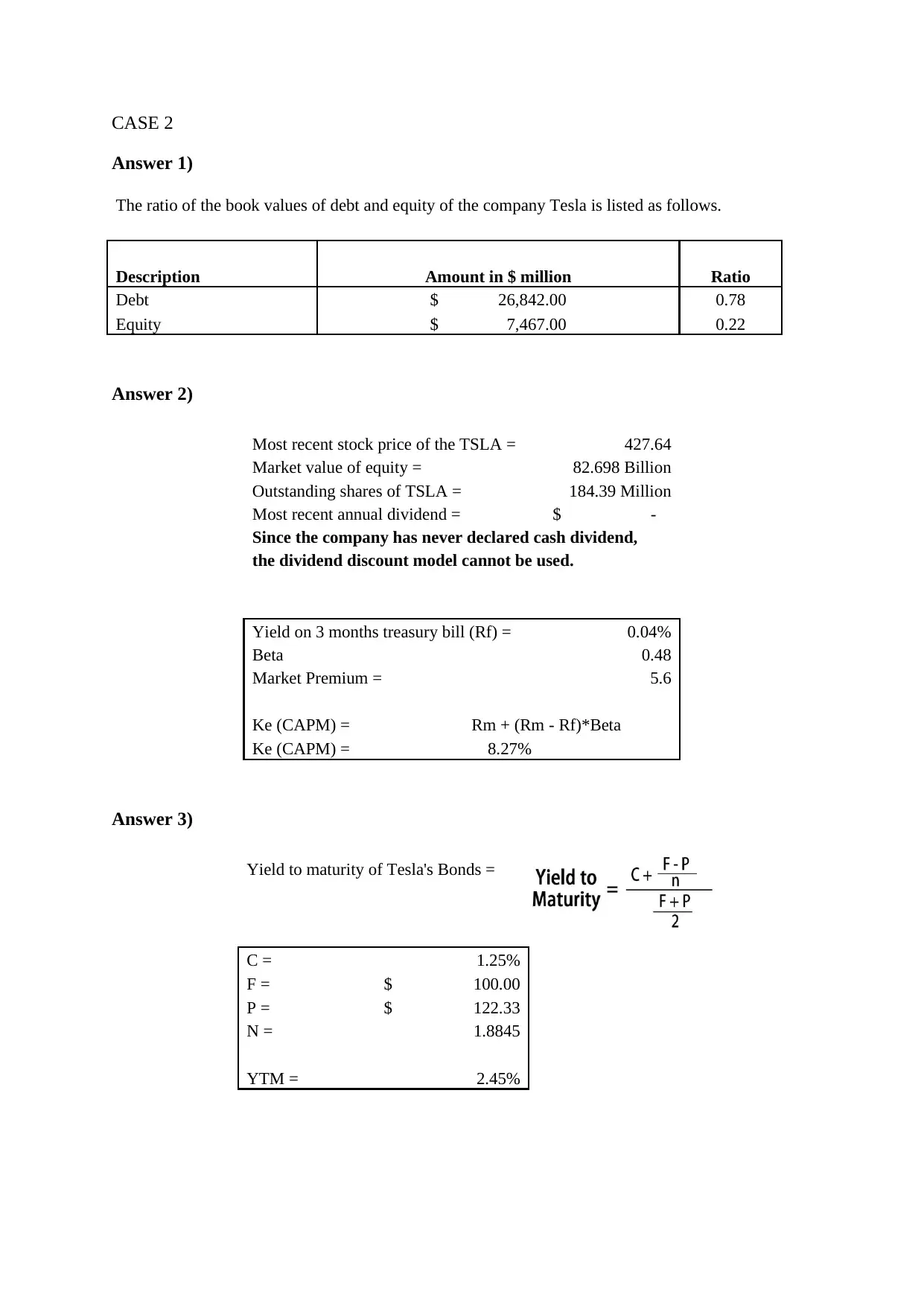
CASE 2
Answer 1)
The ratio of the book values of debt and equity of the company Tesla is listed as follows.
Description Amount in $ million Ratio
Debt $ 26,842.00 0.78
Equity $ 7,467.00 0.22
Answer 2)
Most recent stock price of the TSLA = 427.64
Market value of equity = 82.698 Billion
Outstanding shares of TSLA = 184.39 Million
Most recent annual dividend = $ -
Since the company has never declared cash dividend,
the dividend discount model cannot be used.
Yield on 3 months treasury bill (Rf) = 0.04%
Beta 0.48
Market Premium = 5.6
Ke (CAPM) = Rm + (Rm - Rf)*Beta
Ke (CAPM) = 8.27%
Answer 3)
Yield to maturity of Tesla's Bonds =
C = 1.25%
F = $ 100.00
P = $ 122.33
N = 1.8845
YTM = 2.45%
Answer 1)
The ratio of the book values of debt and equity of the company Tesla is listed as follows.
Description Amount in $ million Ratio
Debt $ 26,842.00 0.78
Equity $ 7,467.00 0.22
Answer 2)
Most recent stock price of the TSLA = 427.64
Market value of equity = 82.698 Billion
Outstanding shares of TSLA = 184.39 Million
Most recent annual dividend = $ -
Since the company has never declared cash dividend,
the dividend discount model cannot be used.
Yield on 3 months treasury bill (Rf) = 0.04%
Beta 0.48
Market Premium = 5.6
Ke (CAPM) = Rm + (Rm - Rf)*Beta
Ke (CAPM) = 8.27%
Answer 3)
Yield to maturity of Tesla's Bonds =
C = 1.25%
F = $ 100.00
P = $ 122.33
N = 1.8845
YTM = 2.45%
Paraphrase This Document
Need a fresh take? Get an instant paraphrase of this document with our AI Paraphraser
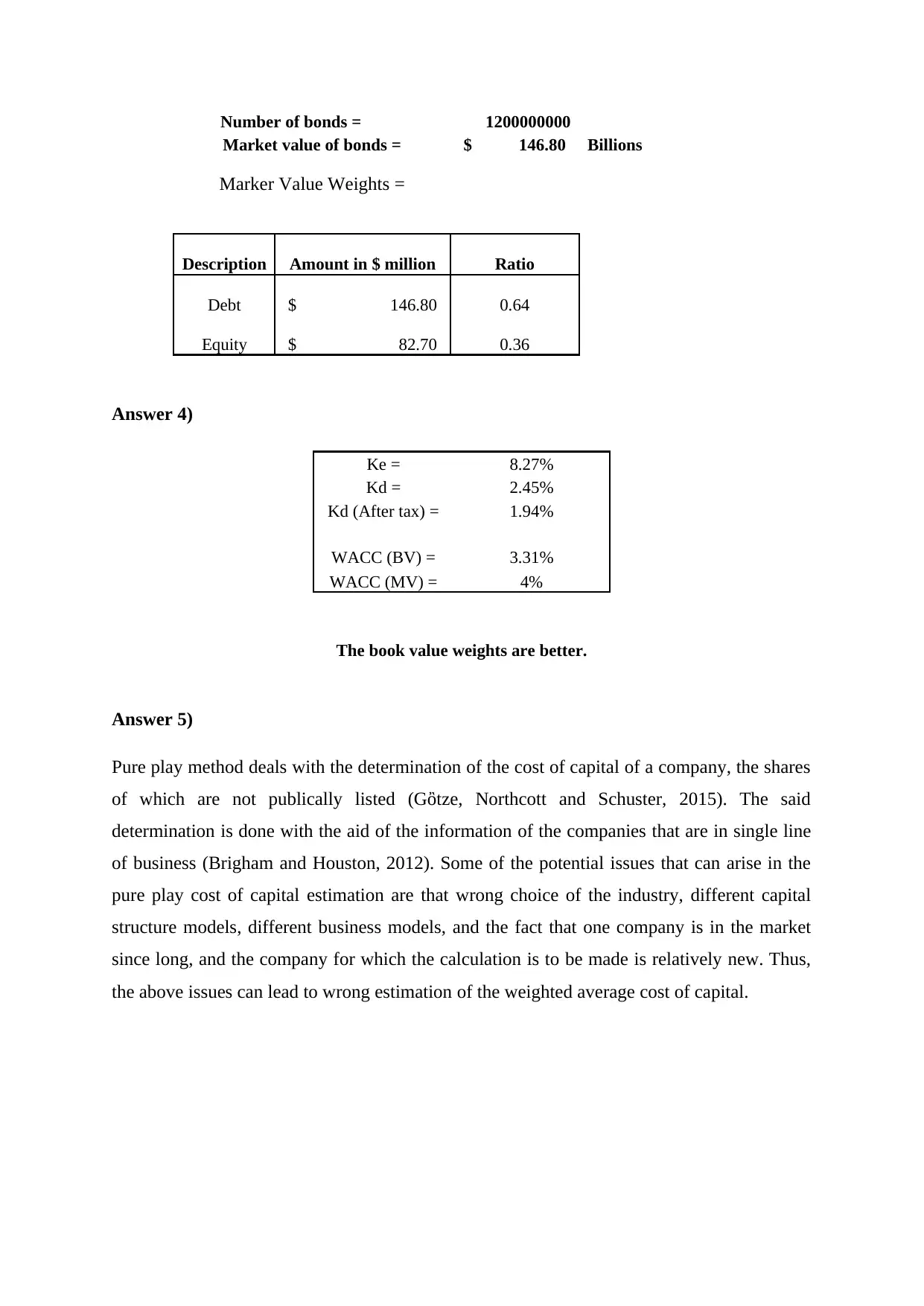
Number of bonds = 1200000000
Market value of bonds = $ 146.80 Billions
Marker Value Weights =
Description Amount in $ million Ratio
Debt $ 146.80 0.64
Equity $ 82.70 0.36
Answer 4)
Ke = 8.27%
Kd = 2.45%
Kd (After tax) = 1.94%
WACC (BV) = 3.31%
WACC (MV) = 4%
The book value weights are better.
Answer 5)
Pure play method deals with the determination of the cost of capital of a company, the shares
of which are not publically listed (Gὂtze, Northcott and Schuster, 2015). The said
determination is done with the aid of the information of the companies that are in single line
of business (Brigham and Houston, 2012). Some of the potential issues that can arise in the
pure play cost of capital estimation are that wrong choice of the industry, different capital
structure models, different business models, and the fact that one company is in the market
since long, and the company for which the calculation is to be made is relatively new. Thus,
the above issues can lead to wrong estimation of the weighted average cost of capital.
Market value of bonds = $ 146.80 Billions
Marker Value Weights =
Description Amount in $ million Ratio
Debt $ 146.80 0.64
Equity $ 82.70 0.36
Answer 4)
Ke = 8.27%
Kd = 2.45%
Kd (After tax) = 1.94%
WACC (BV) = 3.31%
WACC (MV) = 4%
The book value weights are better.
Answer 5)
Pure play method deals with the determination of the cost of capital of a company, the shares
of which are not publically listed (Gὂtze, Northcott and Schuster, 2015). The said
determination is done with the aid of the information of the companies that are in single line
of business (Brigham and Houston, 2012). Some of the potential issues that can arise in the
pure play cost of capital estimation are that wrong choice of the industry, different capital
structure models, different business models, and the fact that one company is in the market
since long, and the company for which the calculation is to be made is relatively new. Thus,
the above issues can lead to wrong estimation of the weighted average cost of capital.
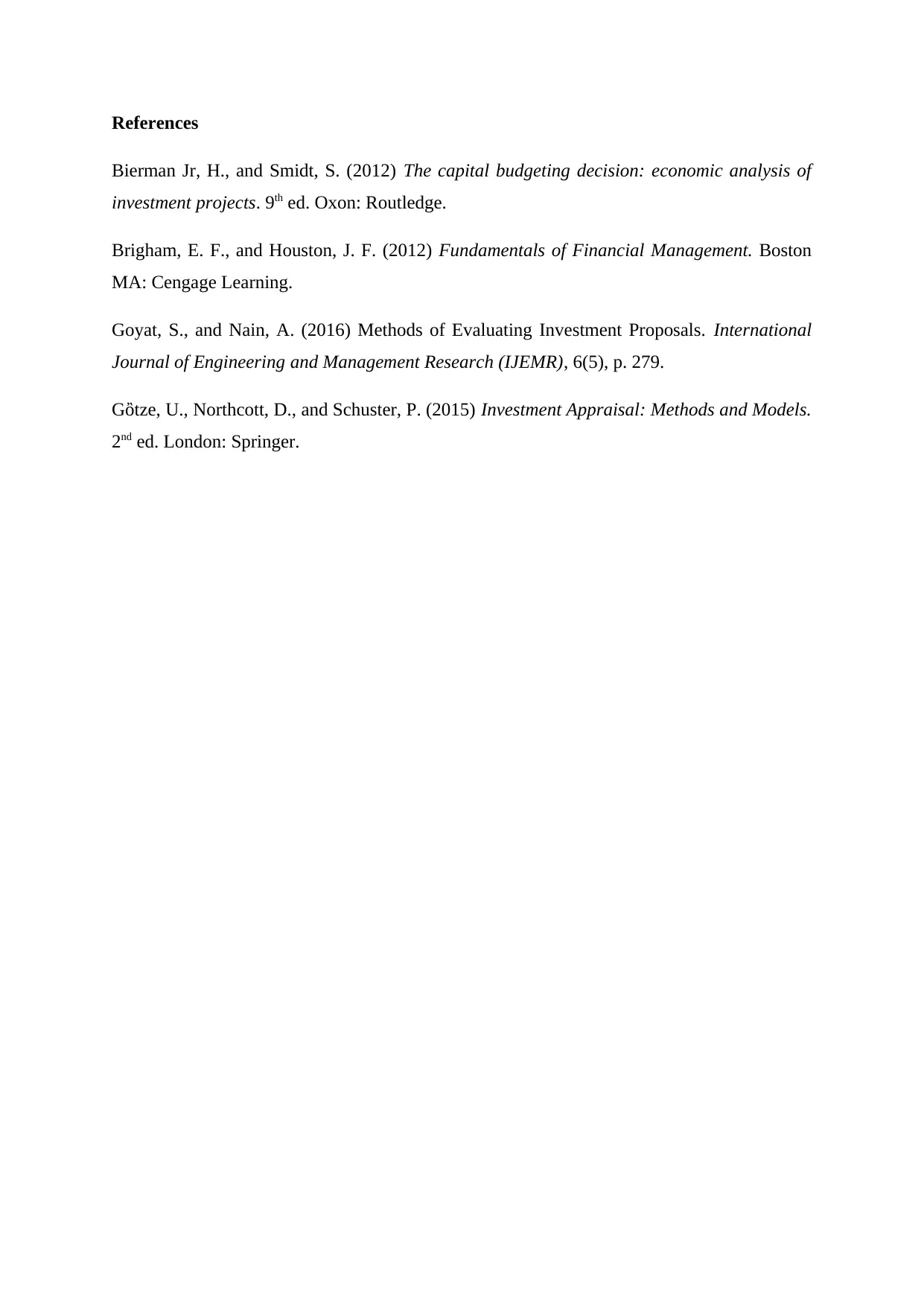
References
Bierman Jr, H., and Smidt, S. (2012) The capital budgeting decision: economic analysis of
investment projects. 9th ed. Oxon: Routledge.
Brigham, E. F., and Houston, J. F. (2012) Fundamentals of Financial Management. Boston
MA: Cengage Learning.
Goyat, S., and Nain, A. (2016) Methods of Evaluating Investment Proposals. International
Journal of Engineering and Management Research (IJEMR), 6(5), p. 279.
Gὂtze, U., Northcott, D., and Schuster, P. (2015) Investment Appraisal: Methods and Models.
2nd ed. London: Springer.
Bierman Jr, H., and Smidt, S. (2012) The capital budgeting decision: economic analysis of
investment projects. 9th ed. Oxon: Routledge.
Brigham, E. F., and Houston, J. F. (2012) Fundamentals of Financial Management. Boston
MA: Cengage Learning.
Goyat, S., and Nain, A. (2016) Methods of Evaluating Investment Proposals. International
Journal of Engineering and Management Research (IJEMR), 6(5), p. 279.
Gὂtze, U., Northcott, D., and Schuster, P. (2015) Investment Appraisal: Methods and Models.
2nd ed. London: Springer.
⊘ This is a preview!⊘
Do you want full access?
Subscribe today to unlock all pages.

Trusted by 1+ million students worldwide
1 out of 6
Related Documents
Your All-in-One AI-Powered Toolkit for Academic Success.
+13062052269
info@desklib.com
Available 24*7 on WhatsApp / Email
![[object Object]](/_next/static/media/star-bottom.7253800d.svg)
Unlock your academic potential
Copyright © 2020–2025 A2Z Services. All Rights Reserved. Developed and managed by ZUCOL.





